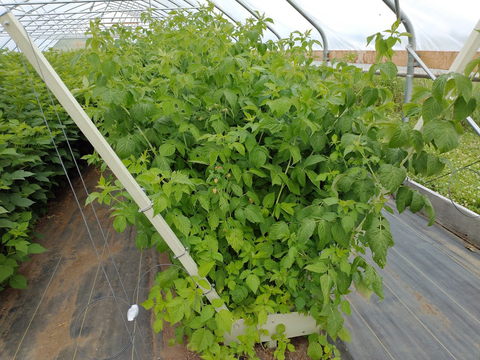Growers must do annual dormant pruning for both primocane- and floricane-fruiting raspberries. Pruning raspberries is simple, especially fall-bearing raspberries.
Raspberries must be trellised if growing in a high tunnel. Many growers also choose to trellis open-field raspberries to make harvest and mowing easier. Trellising canes enhances light penetration and air circulation, thus reducing potential disease and pest pressure.
Primocane-fruiting raspberries
Pruning
A major advantage of primocane-fruiting raspberries is how easy they are to prune.
Simply cut the canes to the ground each year in the late fall or early spring when they are dormant. Use a mower, sharp lopper, or hedge trimmer.
New canes will emerge from the ground in the spring. Since the primocanes produce a full crop of fruit, there is no need to keep floricanes.
If you would like a small summer crop from primocane-fruiting raspberries, you may leave some primocanes behind to form into floricanes. Those floricanes will produce a modest crop again in the coming year. There is no set number to leave, but be sure to space them at least 6 inches apart and leave ample space for new primocanes to grow. You are unlikely to see an overall yield benefit, but some growers want both a summer and fall crop from the same plants. This is not a common practice because it increases labor without a likely yield benefit.
Remove low-hanging trellis wire, twine, drip irrigation, and soil moisture sensors before mowing down canes.
Training
Primocane raspberries require little training. Construct a simple trellis system with removable wires or twine at 2- and 4-foot heights in open-field settings, or 3- and 6-foot heights in high tunnels. Keep canes upright by tucking them between the wires as needed. This functions to keep the aisles clear and facilitate easy harvest.
Primocane plant growth rate increases when grown in tunnels. Thanks to the increased temperature and protection from weather elements, canes can reach 8 feet tall over the growing season.
Floricane-fruiting raspberries
Pruning
Pruning floricane-fruiting raspberries requires more labor hours than primocane-fruiting raspberries but is still very simple.
Floricanes produce fruit for one year and are then removed. While the floricanes are producing fruit, new primocanes are also growing and will produce the next year’s fruit when they become floricanes.
In the late fall after dormancy or in the early spring, cut down all “spent floricanes” — those that have already produced fruit. They are easy to spot because of the old, dried fruit clusters left on the tops of the canes and on laterals. Spent floricanes will also have many lateral fruiting branches.
Leave most of the previous year’s primocanes, as they will become the fruiting floricanes. Only remove some primocanes if the rows are overcrowded. The goal is to have one fruiting cane about every 6 inches.
Training
Floricane-fruiting varieties require a robust trellis system for adequate support. Additional wires located lower than 3 feet, and between 3 and 6 feet, are often needed as floricane-fruiting varieties tend to position fruiting-laterals lower on the cane.
You may decide to separate fruiting canes from the young primocanes in the canopy, by tying the floricanes to one side of the trellis and the primocanes to the other. This tends to make harvest easier, as pickers would have less foliage to search through to find the berries.
Rotating cross arm trellises
“Rotating cross-arm trellises” (RCAT) are modular trellising systems with adjustable posts, used for raspberries and blackberries. The angle of the posts can be adjusted between 45 and 90 degrees from the ground. The trellis wires are strung through the posts, so adjusting the posts changes the angle of the wires and therefore the angle of the canes and berries.
The most common application of this system is to grow the canes at a slightly downward angle, and then raise the posts to a vertical position for harvest. The result is that the berries tend to hang down to one side, reducing labor by making the berries easier to find.
Reviewed in 2022



